بناء فريق جيد ليس لعبة، على الرغم من أنه قد يشبه تجميع أحجية. 🧩
يجب عليك أن تدرس بعناية مواهب الأشخاص وقدراتهم وتستثمر وقتك ومهاراتك القيادية ومهاراتك في الإقناع ومواردك التنظيمية لتوحيد الأشخاص من خلفيات متنوعة من أجل قضية مشتركة. عندها فقط يمكنك الوصول إلى مجموعة يمكنها تحقيق أهدافك المنشودة.
ومع ذلك، فإن المعركة لا تنتهي عند هذا الحد! فبمجرد أن تقوم بتجميع فريقك، يجب عليك تطويره من مجموعة من الأفراد إلى وحدة عالية الإنتاجية ومتماسكة.
في هذه المقالة، سنتعرف في هذه المقالة على خمس مراحل لتطوير الفريق وسنتعرف على كيفية إدارتها لبناء فرق عالية الأداء تنجز المهمة. ولكن قبل ذلك، دعونا نلقي نظرة سريعة على ماهية تطوير الفريق في الواقع.
ما هو تطوير الفريق؟
تمامًا كما نمر بمراحل نمو مختلفة، بدءًا من مرحلة الطفولة إلى سنوات المراهقة إلى مرحلة البلوغ، تمر فرق العمل بالمثل بعملية تطوير طويلة يمكن تقسيمها إلى مراحل متعددة.
إذا كنت قائد فريق وترغب في إخراج أفضل ما لدى كل عضو من أعضاء الفريق، فمن الضروري أن تفهم عملية التطور هذه تمامًا، تمامًا كما هو مهم للآباء والأمهات أن يفهموا رحلة نمو أطفالهم بشكل كامل. يوفر مفهوم مراحل تطور الفريق إطاراً مثالياً لذلك.
5 مراحل تطور الفريق

عبر: الفريق تم تحديد المراحل الخمس لتطور الفريق لأول مرة من قبل عالم النفس الأمريكي بروس توكمان في عام 1965. في مقال بعنوان التسلسلات التنموية في المجموعات الصغيرة ، أوضح توكمان كيف تبدأ الفرق الصغيرة دورات حياتها في مرحلة التكوين وتنتهي في مرحلة التأجيل. إن فهم هذه المراحل ودورك كقائد أو عضو في كل مرحلة منها أمر بالغ الأهمية لضمان نجاح جهدك الجماعي. دعنا نفصلها بالتفصيل.
المرحلة 1: التشكيل
عندما يجتمع أعضاء فريقك على الطاولة للمرة الأولى، عادةً ما يكون هناك القليل من التواصل بينهم أو لا يوجد أي تواصل بينهم. حتى لو كان بعضهم يعرف بعضهم البعض من قبل، فإن هناك الحد الأدنى من التبصر في أساليب العمل أو أساليب العمل في المشروع. وباختصار، فإن أساس علاقة العمل في فريقك في طور التشكل؛ ولهذا السبب تسمى هذه المرحلة بـ بناء الفريق أو مرحلة تشكيل الفريق 🧱
ولكن في الوقت نفسه، هناك الكثير من الحماس بين أعضاء الفريق خلال هذه المرحلة. فهم متحمسون للانضمام إلى شيء جديد والعمل مع أشخاص جدد. قد يظهر هذا الحماس على شكل فضول أو قلق إذا شعروا أنهم ليسوا موهوبين مثل بعض أعضاء فريقهم.
دور قائد الفريق
بصفتك قائد فريق، يتمثل دورك في هذه المرحلة الأولى من تطوير الفريق في التأكد من أن الجميع على دراية بأدوارهم ومسؤولياتهم وكذلك أدوار ومسؤوليات أعضاء فريقهم. فالفهم الواضح تمامًا لهذه الجوانب سيحقق المعجزات من أجل تعاون الفريق وتطوير المجموعة 💁
تقع على عاتقك أيضًا مسؤولية الإجابة عن أي أسئلة قد تنشأ من فضول أعضاء فريقك. وعلاوة على ذلك، عليك أن تخفف من أي قلق بشأن الأداء من خلال إعلامهم بأنه لم يتم اختيارهم لأدوارهم المحددة إلا بعد دراسة دقيقة لمواهبهم وقدراتهم.
المرحلة 2: الاقتحام
عندما يتعرف أعضاء الفريق على بعضهم البعض ويبدأون العمل معًا في المشروع تدريجيًا، قد ينشأ عدد من النزاعات والمشاكل. على سبيل المثال
- قد لا يشعر بعض أعضاء الفريق بالراحة مع أساليب عمل الآخرين
- قد يكون لدى البعض وجهات نظر متضاربة حول كيفية سير المشروع
- قد يعاني البعض من القلق بسبب الحمل الزائد للمعلومات
ودعونا لا ننسى أن بعض أعضاء الفريق قد يكون لديهم أيضًا طموحاتهم أو أجنداتهم الخاصة التي يرغبون في تحقيقها من أجل التقدم الوظيفي السريع.
كل هذه القضايا يمكن أن تخلق بيئة مضطربة، ولهذا السبب تسمى هذه المرحلة الثانية من تطوير الفريق بمرحلة العصف. ⛈️
دور قائد الفريق
يمكن لهذه المرحلة أن تنجح الفرق أو تحطمها اعتمادًا على كيفية إدارة قادة الفريق لها، لذا انتبه إلى كيفية تنقلك هنا. إذا قمت بشرح أدوار ومسؤوليات جميع أعضاء الفريق بشكل صحيح في المرحلة الأولى، فسيكون عملك أسهل. ولكن إذا لاحظت وجود ارتباك وتضارب مستمرين، فقد حان الوقت لتحديدها بوضوح للجميع مرة أخرى (ربما باستخدام برنامج تخطيط القوى العاملة ).
إذا كانت هناك خلافات حول اتجاه المشروع، فإن تحديد مهمة فريقك وهدفه بوضوح يمكن أن يعيدك إلى المسار الصحيح. يمكن أن يجلب الوضوح الذي يحتاج إليه الفريق بأكمله ويساعد في تحديد النهج والاتجاه المثالي للمشروع الذي يمكن أن يكون الجميع مرتاحين له. 🤝
أخيرًا، لا تخافوا من الخلافات. في حين أن النزاعات يمكن أن تكون قاتلة بدون إدارة الفريق فهي ليست بالضرورة سيئة. في الواقع، إنها طبيعية تمامًا بل إنها علامة على أن أعضاء الفريق يضعون كل شغفهم ومعرفتهم في المشروع.
ومع ذلك، من المهم حل أي خلافات على الفور مع السلطة بدلاً من محاولة تجنبها أو إخفائها. هذا النهج يمنع هذه المشاكل البسيطة من التفاقم إلى مشاكل كبيرة يمكن أن تعرض مشروعك للخطر.
المرحلة 3: وضع المعايير
كما قد يوحي اسمها، تشير هذه المرحلة إلى تطبيع العاصفة التي تجمعت بين أعضاء الفريق في المرحلة السابقة. حيث يتكيف أعضاء الفريق تدريجياً مع الأساليب المهنية لبعضهم البعض ويصبحون متقبلين للتغذية الراجعة البناءة من زملائهم أو مديريهم.
دور قائد الفريق
عندما يتوصل أعضاء فريقك إلى فهم بعضهم البعض واتجاه المشروع، فإن مهمتك هي الاستفادة من روح الفريق التي اكتشفت حديثًا من خلال صياغة و عمليات الضبط الدقيق للعمليات وسير العمل التي تتيح التعاون السلس.
بعبارة أخرى، هذا هو الوقت المثالي لـ تحسين العملية . إذا كان لديك بالفعل بعض الإجراءات المعمول بها، فقم بتعديلها قليلاً لتتماشى مع تفاصيل المشروع، بالإضافة إلى شخصيات أعضاء فريقك وأساليب عملهم. على سبيل المثال، إذا كان أعضاء فريقك يشعرون بالإحباط بسبب عدد المرات التي يحتاجون فيها إلى تحديث حالة المشروع، يمكنك تبسيط هذه الخطوة باستخدام أداة أتمتة سير العمل .
المرحلة 4: الأداء
مرحلة الأداء هي المرحلة التي يصل فيها فريقك إلى ذروة الأداء. في هذه المرحلة، من المحتمل أن يكون أعضاء الفريق قد تعلموا الآن كيفية التعاون بفعالية ويتبعون إجراءات محددة جيدًا لتحقيق أهداف فريقك كوحدة واحدة متماسكة. وقد يظهر ذلك في ارتفاع مستويات إنتاجيتهم وانخفاض عدد النزاعات. 🤩
دور قائد الفريق
عندما ينجز أعضاء مجموعتك أهداف المشروع واحدًا تلو الآخر، فقد حان الوقت للاحتفال بالنجاح المشترك. إنها أيضًا اللحظة المثالية لـ تقييم إنتاجيتهم وتقديم ملاحظات بناءة، خاصة لأولئك الذين قد لا يكونون في أفضل حالاتهم. أخيرًا، يجب عليك أيضًا أن تربت على ظهرك لتوجيه فريقك إلى هذه المرحلة.
المرحلة 5: الانصراف
يُشار إلى المرحلة الخامسة أحيانًا بمرحلة الحداد لأنها تحدث عندما يكون المشروع قد انتهى أو حقق الهدف المرجو منه. قد يدخل أعضاء الفريق في فترة من الإنتاجية المنخفضة تحسبًا لتأجيل الفريق.
وقد يعانون أيضًا من العمل في فرق أخرى لبعض الوقت، ويرجع ذلك أساسًا إلى أنهم اعتادوا على أسلوب عمل زملائهم السابقين. وهذا هو بالضبط السبب في أن بداية كل دورة تطوير فريق جديد تكون صعبة للغاية - يجب على أعضاء الفريق التحرر من أساليبهم القديمة وتبني شيء جديد.
دور قائد الفريق
احتفل بكل ما حققته أنت وأعضاء فريقك وفكر فيما كان يمكن القيام به بشكل أفضل. هذه الدروس المستفادة يمكن أن تكون بمثابة دروس لا تقدر بثمن نماذج خطة التطوير عند بناء فريقك القادم.
يمكن أن يكون هذا أيضًا وقتًا تتصاعد فيه المشاعر حيث يدرك أعضاء الفريق أن رحلتهم مع المشروع والأشخاص الذين منحوهم قلوبهم وأرواحهم تقترب من نهايتها. وبصفتك قائدًا، تقع على عاتقك مسؤولية مساعدتهم على إدراك هذه المرحلة الانتقالية وإعدادهم لما ينتظرهم في المستقبل.
كيفية إدارة مراحل تطور الفريق مع ClickUp
لقد استكشفنا بالفعل كيف يجب على القادة إدارة المراحل المختلفة لتطوير الفريق. ومع ذلك، فإن الانتقال من النظرية إلى التطبيق العملي ووضع كل ذلك موضع التنفيذ يمكن أن يكون أمراً صعب المنال، حتى بالنسبة للمدراء الأكثر مهارة. وبصرف النظر عن ذلك، قد يكافح أعضاء الفريق أيضًا لفهم وأداء أدوارهم الخاصة بهم. 🤔
وهنا يأتي دور منصة إنتاجية شاملة مثل ClickUp يتدخل لإنقاذ الموقف (والفريق). إنه إدارة المشاريع ميزات تسهل كل مرحلة من مراحل تطوير الفريق مع مجموعة من الأدوات لإدارة المهام، والتعاون بسلاسة، وتحسين سير العمل، وتتبع الأهداف. دعنا نرى كيف تعمل ClickUp على تقريب الفرق من بعضها البعض في طريقها نحو تنفيذ المشروع بنجاح.
فهم الأدوار والمسؤوليات وسير العمل
يتيح لك ClickUp ما يلي إنشاء المهام وتعيينها لأعضاء الفريق بحيث يكون لدى الجميع فكرة واضحة عما يحتاجون إلى القيام به في أي لحظة معينة. يمكنك استخدام الحقول المخصصة لإسناد المهام بكل التفاصيل اللازمة لإكمالها بنجاح أو إضافة ملفات أو تعليقات أو علامات لسياق إضافي. علاوة على ذلك، يمكن ربط المهام بالعلاقات والتبعيات حتى يتمكن أعضاء فريقك من فهم أولوياتهم بسهولة 🙂
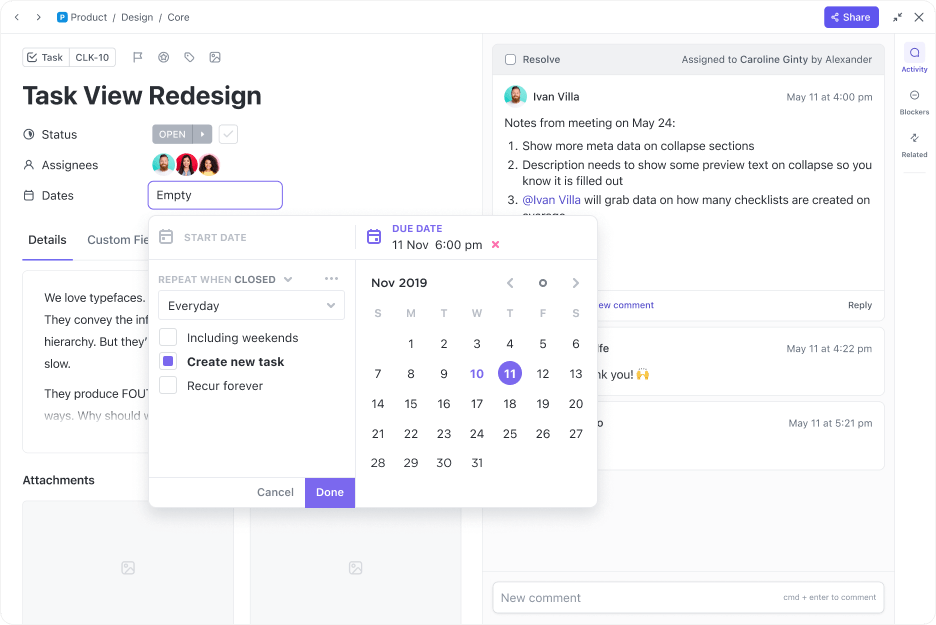
قم بتعيين تواريخ البدء والاستحقاق بسهولة وسرعة داخل المهمة أو استخدم الإعدادات الشرطية لتكرار التواريخ أو إنشاء مهمة جديدة بعد الانتهاء
تتيح لك طرق العرض المتعددة في ClickUp (مثل مخطط جانت، واللوحة، والجدول الزمني، والتقويم، وما إلى ذلك) تصور أي معلومات متعلقة بالمشروع لتسهيل إدارة الفريق والتنسيق. على سبيل المثال، تمنحك طريقتا عرض اللوحة والقائمة نظرة عامة مرتبة على عملك وتقدم المشروع، بينما تتيح لك طريقة عرض التقويم تصور المواعيد النهائية والجداول الزمنية للفريق.
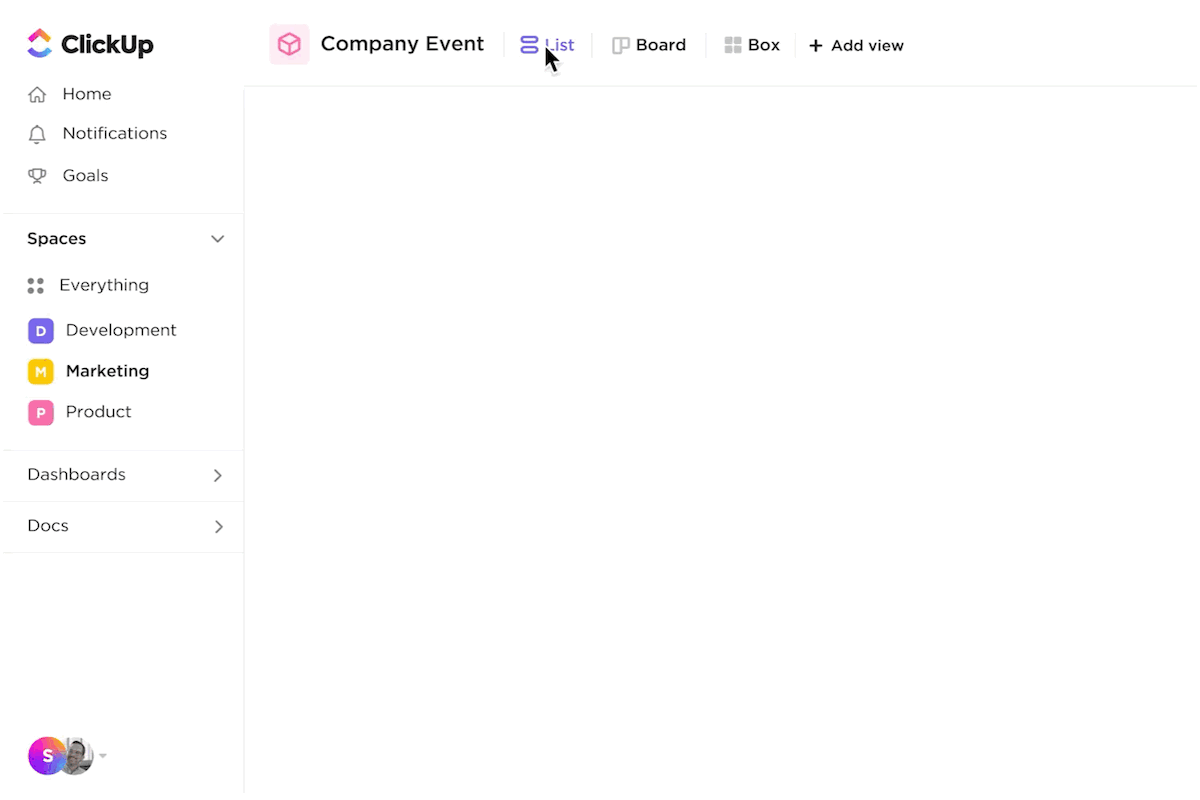
عزز الإنتاجية من خلال تبسيط المهام واستخدام طرق عرض ClickUp القابلة للتكيف لتنظيم جميع أنواع العمل ومراقبتها
علاوةً على ذلك، يسهّل ClickUp العمل ضمن فريق من خلال عرض الفريق والعرض الشخصي (أنا) خيارات. تسمح لك بتحويل التركيز من مهامك الشخصية إلى ما يعمل عليه الفريق بأكمله دون عناء.
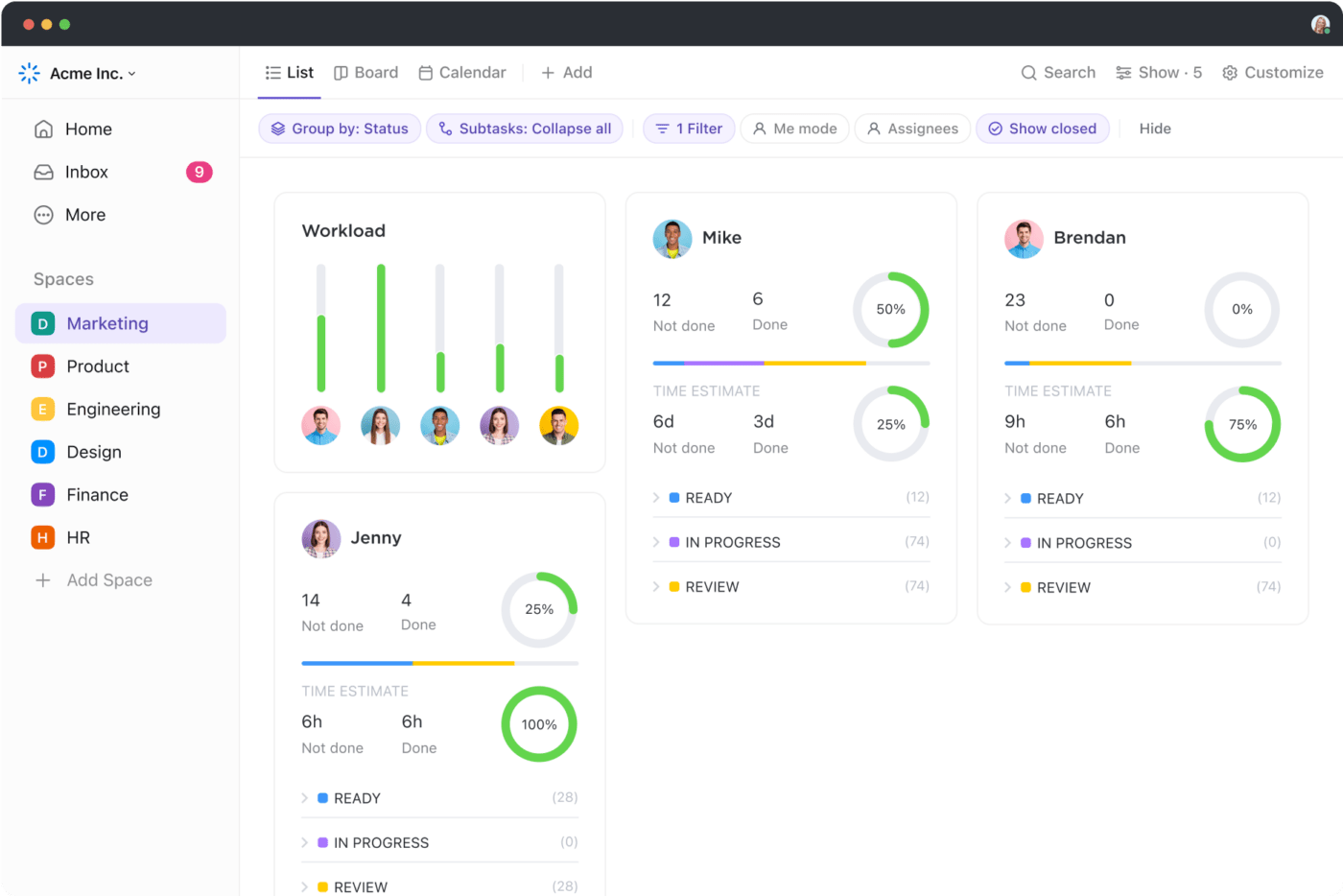
يوفر ClickUp 3.0 عرضًا مبسطًا لرؤية عبء عمل فريقك بأكمله أو عبء عمل فرد ما للحفاظ على سير العمل
يمكنك أيضًا إنشاء ويكي لمشاريعك التي يمكن لأعضاء فريقك الرجوع إليها عند الشك باستخدام مستندات ClickUp أداة إدارة المستندات الخاصة بالمنصة. وهي بمثابة محرر نصوص مدمج لمساحة عمل ClickUp، مما يتيح لك إنشاء مستندات غنية بسهولة وإرفاقها بالمهام أو مشاركتها مع أعضاء فريقك.
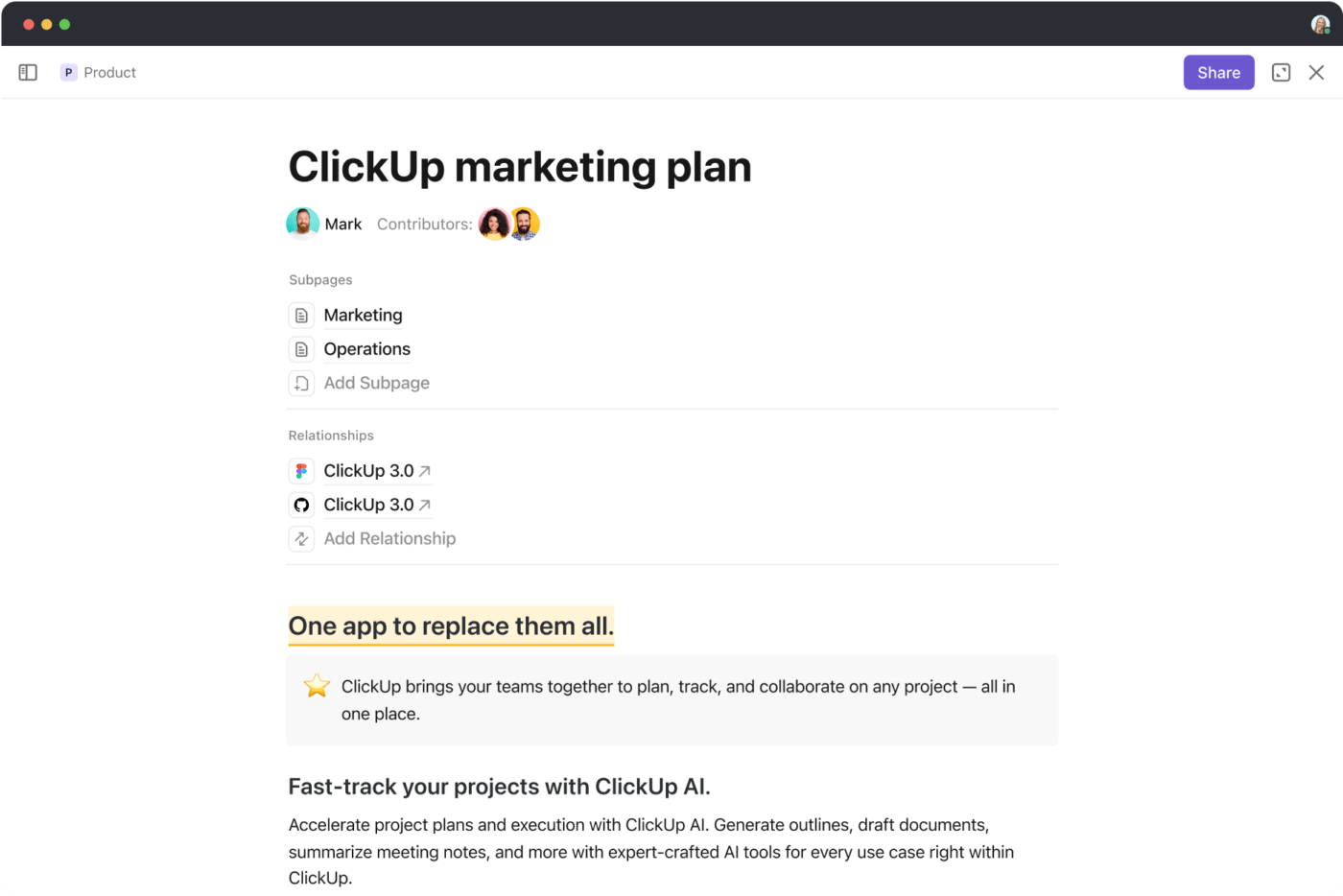
احصل على عرض سريع لجميع صفحاتك الفرعية المتصلة وعلاقاتك على مستندات ClickUp Docs لتظل منظمًا وتحافظ على اتصال العمل
وأخيراً، استخدم انقر فوق الأهداف لتحديد وتتبع الأهداف المحددة والقابلة للقياس والمعالم الرئيسية التي يجب على فريقك والعاملين لديك والأفراد تحقيقها.
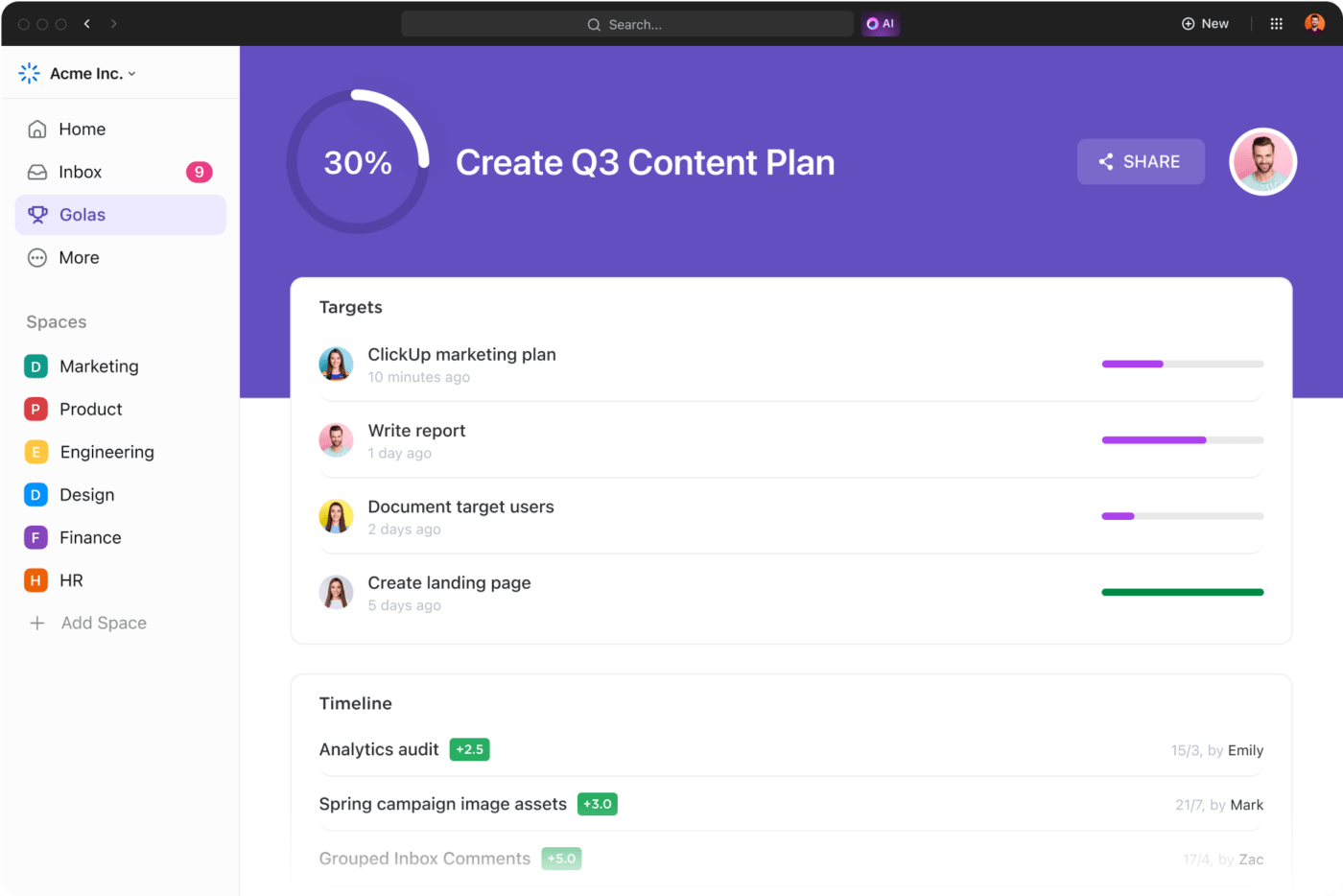
وضع أهداف قابلة للقياس للمهام والمشروعات مع التقدم التلقائي لتحقيق الأهداف بفعالية أكبر مع جداول زمنية محددة وأهداف قابلة للقياس الكمي
التعاون مع أعضاء الفريق
في حين أن هناك العديد من تطبيقات التعاون المتوفرة في السوق في الوقت الحاضر، فإن وجود وظائف تعاونية مدمجة في منصة إدارة المشروع الأساسية الخاصة بك يعمل على تبسيط سير عملك ويقلل من التبديل بين السياقات. لحسن الحظ، يأتي ClickUp مع العديد من الميزات لتسهيل التعاون في المشروع بين أعضاء فريقك 👯
على سبيل المثال ClickUp Whiteboards تتيح لفريقك وضع الخطط وتصور العمليات باستخدام الملاحظات اللاصقة والرسومات والكتل النصية وما إلى ذلك. باستخدام عرض ClickUp Chat يمكن لأعضاء فريقك التواصل مع بعضهم البعض وطرح الأسئلة المتعلقة بالعمل، بينما تتيح لهم ميزات مثل وضع العلامات والتعليق ومشاركة الملفات التعاون في الملفات والأصول الأخرى داخل مساحة عمل ClickUp. ClickUp Mind Maps تتيح لهم رسم عمليات الفريق مع المهام المضمنة فيها لفهم أفضل وتنفيذها بسهولة.
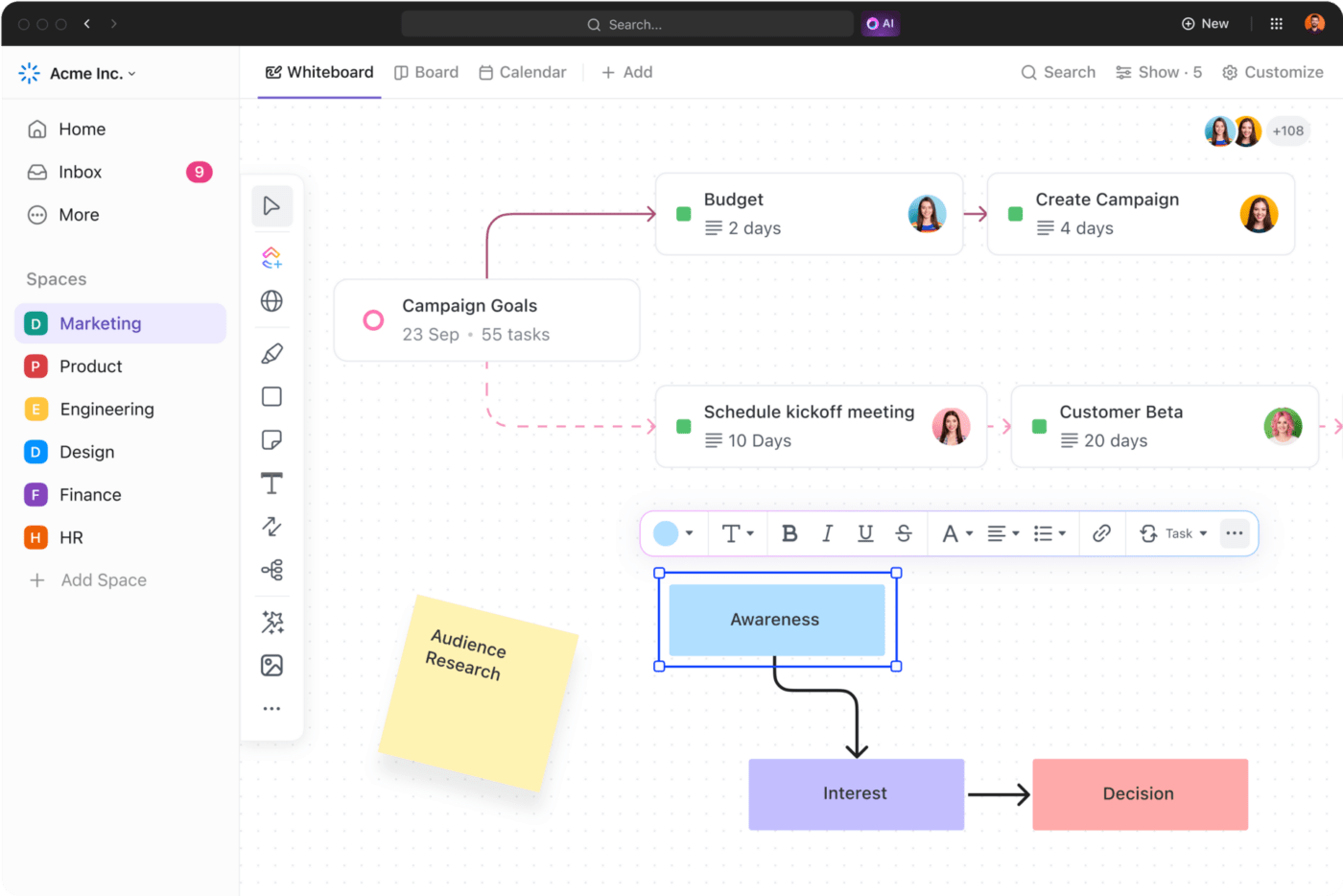
قم بالعصف الذهني أو وضع الاستراتيجيات أو تخطيط سير العمل باستخدام لوحات ClickUp Whiteboards التعاونية المرئية
تتبع حالة المشروع والإنتاجية
أخيرًا وليس آخرًا، يمكن ل ClickUp مساعدتك في تتبع المشروع من خلال السماح لك بمراقبة أهداف الفريق، ومؤشرات الأداء الرئيسية، وإنتاجية جميع أعضاء الفريق على حسب الطلب لوحات معلومات ClickUp .
ومع رؤى وتقارير فريق ClickUp يمكنك بسهولة تتبع بيانات أداء الفريق أو أي مقياس آخر وتصورها من لوحة التحكم الخاصة بك. يمكنك أيضًا مشاركة البيانات مع أصحاب المصلحة الآخرين في التقارير التي يمكن إنشاؤها بسرعة بمساعدة التقارير الجاهزة قوالب التقارير . 📄
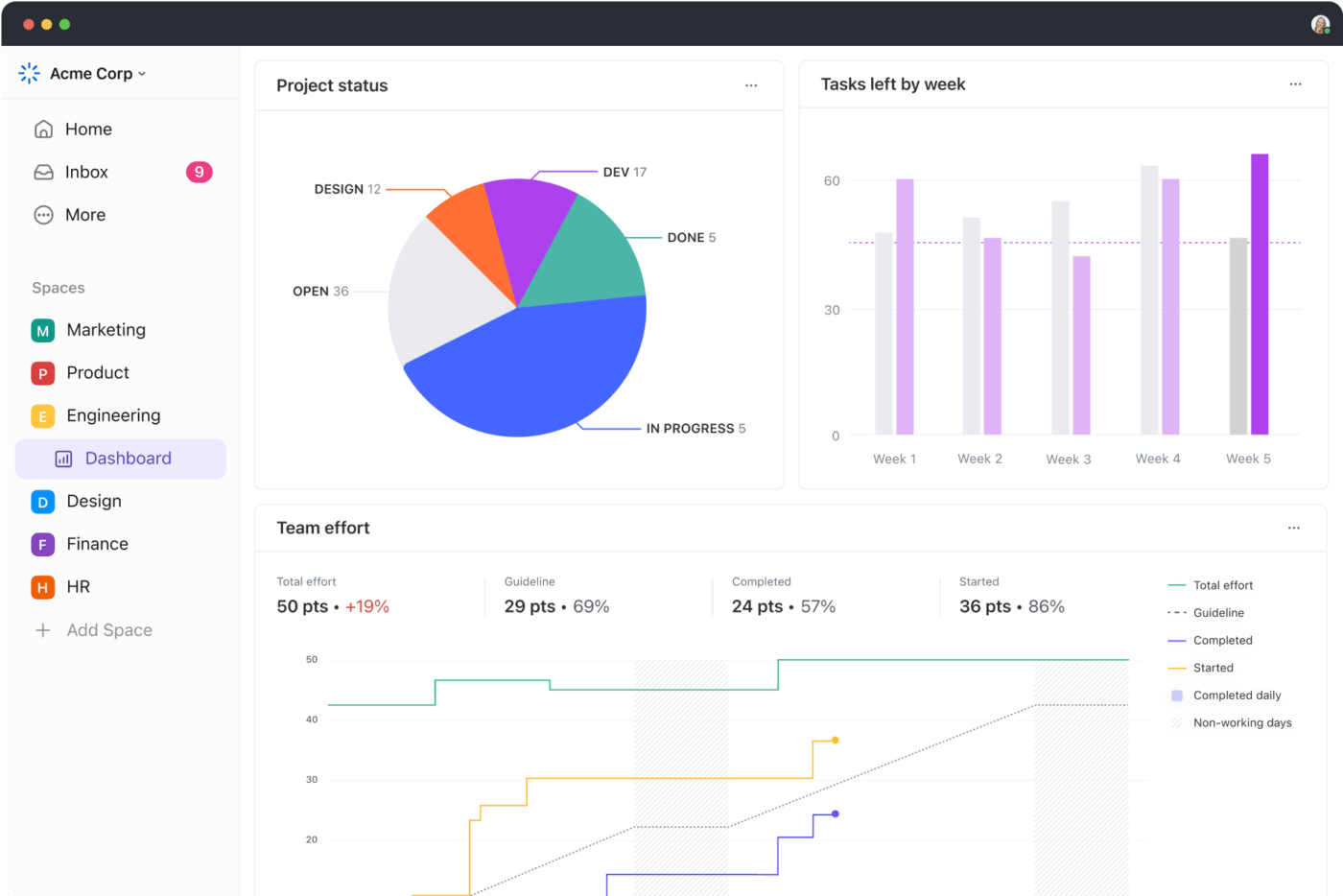
احصل على عرض شامل لحالات المشروع والمهام المتبقية في فريقك أو قسمك باستخدام لوحات المعلومات في ClickUp 3.0
ClickUp: سلاحك السري لتطوير فريق العمل بفعالية
هناك الكثير مما يمكن القيام به لإدارة فريقك ومشاريعك بنجاح باستخدام ClickUp - الميزات المذكورة هنا هي فقط غيض من فيض. استكشف الباقي من خلال الاشتراك في ClickUp مجانًا وشاهد كيف تساعدك أنت وفريقك على النجاح في كل مرحلة من مراحل تطوير المجموعة. 🤞

